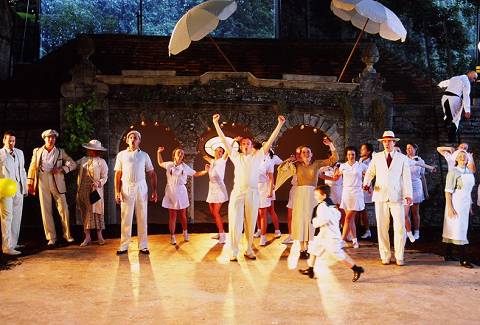|
<< -- 5 -- Roderic Dunnett FEMALE INSURGENCE

Janácek's Osud not only preceded Mr Broucek, Katya
Kabanová and Makropoulos : Janácek began it even
before the Brno première of Jenufa in January 1904, during
the period of his obsession with one of his many muses, Kamila Urvalková
(the more important Kamila Stösslová came later), and before
Dvorák's death at the start of May 1904. Mirka Zemanová (in
her recent book on Janácek) cannot be far wrong in seeing it as a
direct response to verismo, its writing 'among the most lyrical,
passionate and voluptuous Janácek ever wrote.'
Niki Turner's intelligent, economical set, costumes and properties ingeniously
took up where Sárka left off -- recycling, like a kind of photographic
negative, the sacred circular clearing or temenos that formed the
clearing of Premysl's primeval princely court. Having caught the spaciousness
of Sárka's score, Elgar Howarth drove Osud's music
forward with energy, and to equal effect : Janácek's prominently-employed
brass played for him like heroes, and the vivid chorus bettered even Sárka's
noble finale.
Act I of Osud begins (as does Act III) with a party atmosphere
-- all waltzes (pirouetting flutes and violins, pecking trombones and violas)
and balloons, with support characters in tennis whites, and tenor Adrian
Thompson's Zivný, a composer struggling in black, hovering like some
gloomy presence from film noir. Director Olivia Fuchs's eye for detail
was a joy (compare David Pountney's incisive Martinu Julietta, to
be revived by Opera North in early 2003) : characters dotted around in constantly
varying precise tableaux, fussing over binoculars, fans, parasols, the daily
newspaper.

A scene from Garsington Opera's vibrant 2002 production of Janácek's 'Osud'.
Photo: Keith Saunders
|
There are many singing roles in the beleaguered Zivný's entourage,
professional types, each well defined : I liked Pencarreg's stomachy Lhotki,
Olivia Keen's mezzo Mila, Dyfed Wyn-Evans's thin, bespectacled, ever-courteous
Konecny, tenor Christopher Gillett's admirably sung Dr Suda, and Jane Leslie
MacKenzie's schoolmarm (the comically named Miss Stuhla) nursing a clutch
of tennis-playing girls and athletically stretching youths, all as perky
as the children from Dvorák's Jacobin. A massive energy was
built up here, and much jollity, which is just what this dark but jovial
piece -- more Strauss than Strauss, and embracing some of the most rapturous
music Janácek ever composed -- requires.
Continue >>
Copyright © 4 October 2002
Roderic Dunnett, Coventry, UK

|

